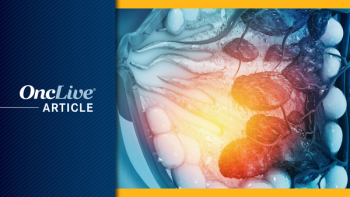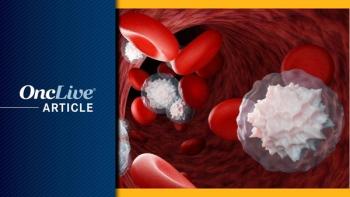
MRD-Guided Treatment Approach Generates Excitement in Stage II to III Colon Cancer
The utilization of a circulating tumor DNA assay to detect the presence of minimal residual disease may provide an opportunity to better inform treatment decisions in patients with early-stage colon cancer.
The utilization of a circulating tumor DNA (ctDNA) assay to detect the presence of minimal residual disease (MRD) may provide an opportunity to better inform treatment decisions in patients with early-stage colon cancer, according to Georges Azzi, MD.
Specifically, in the
Those who are determined to have MRD negativity will be randomized to receive standard-of-care (SOC) adjuvant chemotherapy or to undergo observation unless ctDNA is subsequently detected. Those who are found to have MRD positivity will be randomized to receive SOC chemotherapy or an intensified regimen of mFOLFIRINOX (oxaliplatin, leucovorin, irinotecan, and 5-fluorouracil).
“I would encourage everyone to enroll on this study,” Azzi said. “It is an important study for our patients. It also gives [us] the potential to help advance the science, and [for patients to] potentially skip chemotherapy and be closely surveilled. If they are positive, [patients have] the ability to escalate therapy on study.”
In an interview with OncLive®, Azzi, co-director of the Department of Hematology/Oncology, Prostate Cancer, at Holy Cross Health, discussed the promise of personalized, tumor-informed ctDNA assays utilized for the detection of MRD and how this approach can potentially shift the management of patients with colon cancer.
OncLive®: What was the rationale for the CIRCULATE-US study?
Azzi: We know that adjuvant chemotherapy, as it currently stands, does not cure all patients. The premise [of this research is] to try and improve [upon what is seen with] the current adjuvant chemotherapy regimens that we give to patients after surgery. [We want] to be able to escalate [treatment] in those patients who are [at] the highest risk [for recurrence].
The most valuable tool in the clinic to evaluate where patients [fall] on that spectrum of risk is tumor-informed ctDNA, [which we use to assess] MRD. [We know that] patients who test positive 4 weeks after their surgery have a much higher risk of recurrence. This will be the premise of randomization in CIRCULATE-US, where there will be the ability to de-escalate [treatment] for negative patients and escalate for positive patients.
Could you expand on the design of the study and the methods that will be utilized? What are the key inclusion criteria?
From the published schema of the study, we see that the plan is to perform a tumor-informed ctDNA assay within 6 to 8 weeks of surgery. [The test results] will [help to] randomize [those with] stage [II or III disease]. They have a requirement for a R0 resection, as well as proficient MMR and microsatellite stable [disease].
The ctDNA assay that is used in this study will be the Signatera assay by Natera. If ctDNA is detected, then there is randomization between the current standard of care, which is FOLFOX or CAPOX for 6 months, vs FOLFOXIRI. If [it is] not detected, there will be the randomization between CAPOX or FOLFOX vs surveillance with serial ctDNA.
If ctDNA is not detected, the patient will not continue to receive chemotherapy. However, if it is detected during the follow-up, the patient will be randomized to receive the 6 months of FOLFOX vs FOLFOXIRI. They will join the second arm of the study if ctDNA is detected throughout the surveillance. This first arm will test chemotherapy given right away vs delayed escalated chemotherapy.
The ctDNA assay that you mentioned has also been leveraged in the CIRCULATE Japan study. What have been the results that have been reported from that study thus far?
The study, which was the largest prospective tumor-informed ctDNA study done [to date], enrolled 1200 patients. [Data] on the first [approximately] 800 patients were analyzed and presented. [We saw] great performance of the tests, with a 95% presurgical detection rate in those patients.
At the 4-week time point, [postoperative ctDNA positivity] was associated with [inferior disease-free survival] in patients with stage I to III disease, with a hazard ratio of 24.4. If [a patient] was positive, [ctDNA] was able to detect relapse. [We saw] the ability to distinguish high-risk patients vs patients who will do better.
How did this ctDNA assay become deemed the assay of choice for this study? Have we seen it approved in any other indications?
Currently, this ctDNA assay has the most validation data available currently and it has a good performance for the detection of metastatic disease. In CIRCULATE Japan, we saw a 93% sensitivity [rate] for detection of recurrence. I believe that is why this assay has been selected for [CIRCULATE-US].
[Beyond this, we have also] seen Medicare approval for immunotherapy monitoring [with the] tumor-informed ctDNA assay. There, [the assay is] being used in the advanced cancer setting to monitor molecular tumor burden. If patients are responding [to treatment], you would see a decrease in the molecular tumor burden whereas if they are not responding, you would see an increase. To predict that at 6 weeks after treatment vs many months on imaging, [represents] the ability to detect response or progression, as well as the ability to differentiate pseudoprogression from progression, which is important with immunotherapy.
How might this assay fill an unmet need?
If we do not use an assay like this, we are in a Blackbox setting, unable to tell who is high risk and who is not. We see the pathological criteria, even positive lymph nodes, and the hazard ratio is not as good for prediction of DFS as the ctDNA assay with the tumor-informed approach. This is the best assay we have to [help us] differentiate higher risks from lower risks.
The unmet need is the ability to pinpoint those patients who will relapse, to be able to eventually enroll them on trials, such as CIRCULATE-US, and escalate therapy to hopefully show a difference. On the other hand, in the future, [this may also be leveraged] to show that many patients can skip chemotherapy if they [test] negative.
Reference
- Natera’s Signatera test selected for NRG Oncology’s landmark CIRCULATE-US study of MRD-guided treatment in stage II-III colon cancer. News release. Natera, Inc.; September 7, 2021. Accessed February 22, 2022.
https://bit.ly/3EOTJ2c

























































































